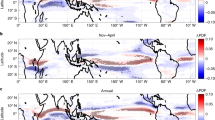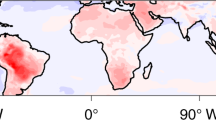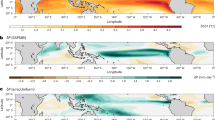Abstract
Some of the earliest unequivocal signs of climate change have been the warming of the air and ocean, thawing of land and melting of ice in the Arctic. But recent studies are showing that the tropics are also changing. Several lines of evidence show that over the past few decades the tropical belt has expanded. This expansion has potentially important implications for subtropical societies and may lead to profound changes in the global climate system. Most importantly, poleward movement of large-scale atmospheric circulation systems, such as jet streams and storm tracks, could result in shifts in precipitation patterns affecting natural ecosystems, agriculture, and water resources. The implications of the expansion for stratospheric circulation and the distribution of ozone in the atmosphere are as yet poorly understood. The observed recent rate of expansion is greater than climate model projections of expansion over the twenty-first century, which suggests that there is still much to be learned about this aspect of global climate change.
This is a preview of subscription content, access via your institution
Access options
Subscribe to this journal
Receive 12 print issues and online access
$259.00 per year
only $21.58 per issue
Buy this article
- Purchase on Springer Link
- Instant access to full article PDF
Prices may be subject to local taxes which are calculated during checkout


Similar content being viewed by others
References
Gnanadesikan, A. & Stouffer, R. J. Diagnosing atmosphere-ocean general circulation model errors relevant to the terrestrial biosphere using the Köppen climate classification. Geophys. Res. Lett. 33, L22701 (2006).
Lee, S. & Kim, H.-K. The dynamical relationship between subtropical and eddy-driven jets. J. Atmos Sci. 60, 1490–1503 (2003).
Vallis, G. K. Atmospheric and Oceanic Fluid Dynamics: Fundamentals and Large-Scale Circulation (Cambridge University Press, Cambridge, UK, 2006).
Meehl, G. A. et al. in Climate Change 2007: The Physical Science Basis. Contribution of Working Group I to the Fourth Assessment Report of the Intergovernmental Panel on Climate Change (eds Solomon, S. et al.) (Cambridge University Press, Cambridge, UK, 2007).
Trenberth, K. E. et al. in Climate Change 2007: The Physical Science Basis. Contribution of Working Group I to the Fourth Assessment Report of the Intergovernmental Panel on Climate Change (eds Solomon, S. et al.) (Cambridge University Press, Cambridge, UK, 2007).
Hudson R. D., Andrade, M. F. Follette, M. B. & Frolov A. D. The total ozone field separated into meteorological regimes – Part II: Northern Hemisphere mid-latitude total ozone trends. Atmos. Chem. Phys. 6, 5183–5191 (2006).
Fu, Q., Johanson, C. M., Wallace, J. M. & T. Reichler, Enhanced mid-latitude tropospheric warming in satellite measurements. Science 312, 1179 (2006).
Seidel, D. J., & Randel R. J., Recent widening of the tropical belt: Evidence from tropopause observations. J. Geophys. Res. 112, D20113 (2007).
Hu, Y. & Fu, Q. Observed poleward expansion of the Hadley circulation since 1979. Atmos. Chem. Phys. 7, 5229–5236 (2007).
Santer, B. D. et al. Contributions of anthropogenic and natural forcing to recent tropopause height changes. Science 301, 479–483 (2003).
Seidel, D. J. & Randel, W. J. Variability and trends in the global tropopause estimated from radiosonde data. J. Geophys. Res. 111, D21101 (2006).
Zhou, X. L., Geller, M. A. & Zhang, M. H. The cooling trend of the tropical cold point tropopause temperatures and its implications. J. Geophys. Res. 106, 1511–1522 (2001).
Worden, J. et al. Importance of rain evaporation and continental convection in the tropical water cycle. Nature 445, 528–532 (2007).
Lu, J., Vecchi, G. A. & Reichler, T. Expansion of the Hadley cell under global warming. Geophys. Res. Lett. 34, L06805 (2007).
Lau, N.-C., Leetmaa, A. & Nath, M. J. Attribution of atmospheric variations in the 1997–2003 period to SST anomalies in the Pacific and Indian Ocean basins. J. Climate 19, 3607–3628 (2006).
Frierson, D., Lu, J. & Chen, G. The width of the Hadley cell in simple and comprehensive general circulation models. Geophys. Res. Lett. 34, L18804 (2007).
Williams, G. P. Circulation sensitivity to tropopause height. J. Atmos. Sci. 63, 1954–1961 (2006).
Lorenz, D. J. & DeWeaver, E. T. Tropopause height and zonal wind response to global warming in the IPCC scenario integrations. J. Geophys. Res. 112, D10119 (2007).
Held, I. M. & Hou, A. Y. Nonlinear axially symmetric circulations in a nearly inviscid atmosphere. J. Atmos. Sci. 37, 515–533 (1980).
Taguchi, M. & Hartmann, D. L. Increased occurrence of stratospheric sudden warmings during El Nino as simulated by WACCM. J. Climate 19, 324–332 (2006).
Walker, C. C. & Schneider, T. Eddy influences on Hadley circulations: Simulations with an idealized GCM. J. Atmos. Sci. 63, 3333–3350 (2006).
Seager, R. et al. Model projections of an imminent transition to a more arid climate in southwestern North America. Science 316, 1181–1184 (2007).
Forster, P. M. de F. & Shine K. P. Assessing the climate impact of trends in stratospheric water vapor. Geophys. Res. Lett. 29, 1086 (2002).
Kirk-Davidoff, D. B., Hintsa, E. J., Anderson, J. G. & Keith, D. W. The effect of climate change on ozone depletion through changes in stratospheric water vapour. Nature 402, 399–401 (1999).
Lovelock, J. E. The Revenge of Gaia: Why the Earth Is Fighting Back — and How We Can Still Save Humanity (Allen Lane, London, 2006).
Kushner, P. J., Held, I. M. & Delworth, T. L. Southern Hemisphere atmospheric circulation response to global warming. J. Climate 14, 2238–2249 (2001).
Polvani, L. M. & Kushner, P. J. Tropospheric response to stratospheric perturbations in a relatively simple general circulation model. Geophys. Res. Lett. 29 (2002).
Haigh, J. D., Blackburn, M. & Day, R. The response of tropospheric circulation to perturbations in lower-stratospheric temperature. J. Climate 18, 3672–3685 (2005).
Yin, J. H. A consistent poleward shift of the storm tracks in simulations of 21st century climate. Geophys. Res. Lett. 32, L18701 (2005).
Bengtsson, L., Hodges, K. I. & Roeckner, E. Storm tracks and climate change. J. Climate 19, 3518–3543 (2006).
Gillett, N. P. Northern hemisphere circulation. Nature 437, 496 (2005).
Acknowledgements
We thank Celeste Johanson (University of Washington) for providing analysis of tropical widening trends in climate model simulations for the twenty-first century. The National Center for Atmospheric Research is sponsored by the US National Science Foundation. T.J.R. was supported by NSF grant ATM0532280 and by NOAA grant NA06OAR4310148. Q.F. is supported by NOAA Grant NA17RJ1232.
Author information
Authors and Affiliations
Corresponding author
Rights and permissions
About this article
Cite this article
Seidel, D., Fu, Q., Randel, W. et al. Widening of the tropical belt in a changing climate. Nature Geosci 1, 21–24 (2008). https://doi.org/10.1038/ngeo.2007.38
Published:
Issue Date:
DOI: https://doi.org/10.1038/ngeo.2007.38
This article is cited by
-
Retrieval of the Hadley circulation boundaries at regional scales using global positioning system-radio occultation measurements
GPS Solutions (2024)
-
Uncertainties of ENSO-related Regional Hadley Circulation Anomalies within Eight Reanalysis Datasets
Advances in Atmospheric Sciences (2024)
-
Modulations of NAO on the interplay between monsoon and westerlies in Asia on interdecadal timescales
Climate Dynamics (2024)
-
Human-induced weakening of the Northern Hemisphere tropical circulation
Nature (2023)
-
Atmospheric trends explained by changes in frequency of short-term circulation patterns
Communications Earth & Environment (2023)



